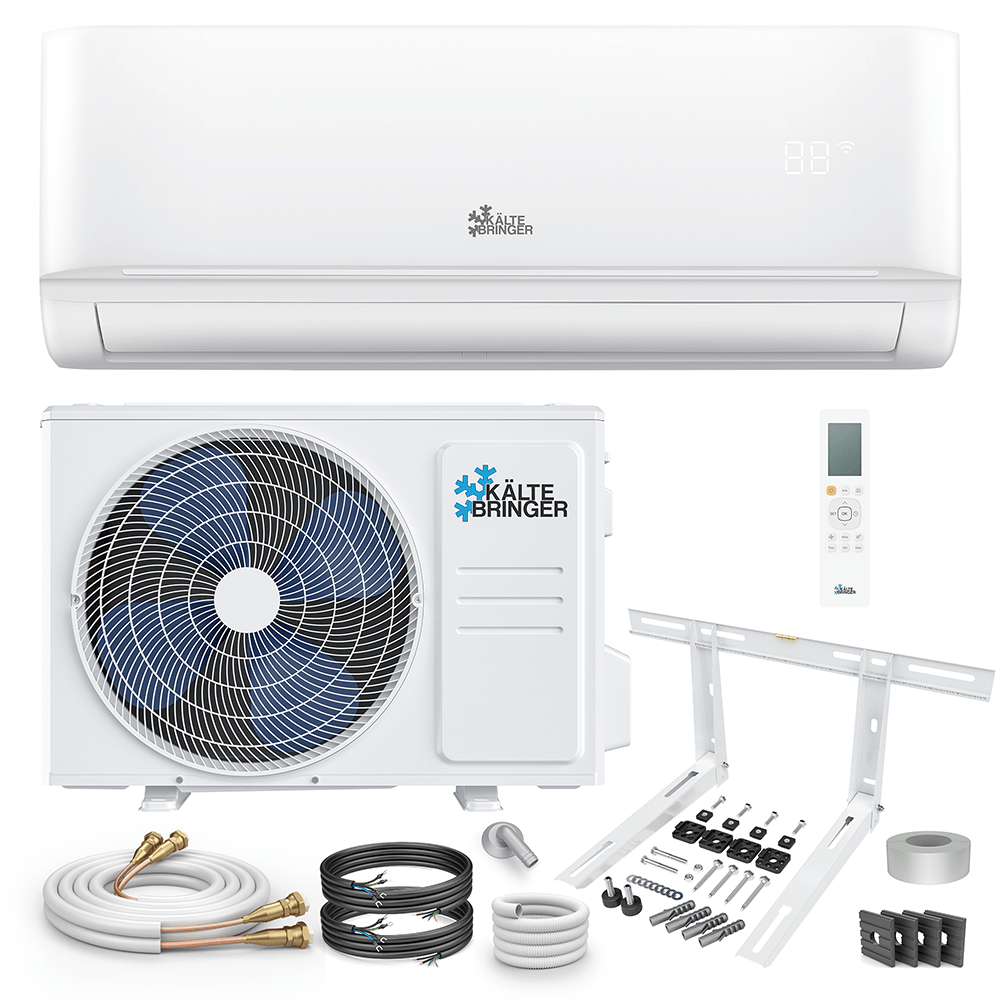Many people look forward to winter because that is when the cozy time of the year begins. For many, a long evening on the couch with a cup of tea is just the right way to end a long day at work. The heat pump is touted by many magazines and forums as the winter heating solution, but is it really? We have taken a look for you to see whether you can effectively heat a living space with the heat pump even in winter.
Advantages of an air-to-air heat pump in your own home
The air-to-air heat pump is the favorite of many house and apartment owners because it is comparatively quick and easy to install. Heat pumps are installed in all Kältebringer air conditioning systems, so the devices have a function both in summer and in winter. So that you can better understand when a heat pump makes sense, we would like to briefly and simply explain their function.
Every heat pump uses existing ambient heat to conduct it into the house. There are various options here: from the ground, from the water or – as with the split air conditioning system – from the air. It's hard to believe, but even at colder temperatures there is still enough heat in the outside air, which can then be compressed using a refrigerant and released into the room. Some heat pumps also transfer the absorbed heat to the heating water. This makes sense because both heating systems can be used at the same time.
Cool air conditioners use a different type of heat pump, called an air-to-air heat pump. This means nothing other than that the system draws in air with the help of an outdoor unit, extracts the heat from it and then emits it back inside. This type of heating has the following advantages, among others:
- No connection to heating system or pipes required
- Very cheap to buy & low installation costs
- Regulation of humidity through smart functions
- In summer, the heat pump can be used as an air conditioner
- The air-to-air heat pump takes up little space
- Low maintenance costs & few vulnerable components
- Compared to other heat pumps, low power consumption with high performance
As you can see, the air-to-air heat pump is the best alternative if you want to retrofit a system in addition to your permanently installed heating. The devices are inexpensive to buy and are hardly noticeable in the apartment. More detailed information about our heat pumps can be found here.
Is the air-to-air heat pump also suitable on particularly cold days?
Not everyone has the opportunity to install a heat pump in their house that supplies them with heat from the ground. Such a brine heat pump is associated with high costs and structural measures, since a probe has to be drilled into the ground. However, there is enough heat in the ground to heat up a house pleasantly warm even at temperatures below -20 degrees Celsius, without additional measures.
When it comes to effective heating in winter, the rumor persists that the air-to-air heat pump can no longer function above a certain outside temperature. But is that really true? We took a closer look to see whether you can also rely on such a heat pump in winter.
One thing is true, of course: above a certain outside temperature and when the air is very dry, there is only a little heat left in the outside air. Accordingly, the air-to-air heat pump also has a harder time heating effectively. It's just a rumor that it doesn't work at all.
Technically, the heat pump is able to draw enough heat from the outside air even at -20 degrees Celsius. In very cold weather, however, it may be necessary to heat up. A so-called heating element is then activated in the heat pump, which heats up the supplied air. This results in higher energy consumption, but makes heating possible even in the depths of winter.
However, the air-to-air heat pump is almost no longer suitable as the sole heating system from -10 degrees. It only makes sense for houses with a very low heating requirement and very good insulation. The heat requirement should not exceed 1 watt per square meter. You can easily calculate your personal requirements with our heat load calculator .
Conclusion: Even in very cold weather, the air-to-air heat pump can still make sense. However, you should clarify all eventualities in advance if you live in a very cold area. But: In Germany it doesn't get really cold in December and January anymore. Temperatures below -10 degrees are rarely reached, and so the heat pump from Kältebringer can be a good solution. For those who are undecided: In the next section we will look at how you can combine a heat pump with your permanently installed heating system.
The ideal solution: heat pump for the transitional period
It is understandable that you may not want to convert your heating system completely to the heat pump. There is a risk of excessive power consumption, especially in large or poorly insulated rooms. For anyone who still wants to save on heating costs, the heat pump can also be used as heating in the transitional period.
You know it for sure: In autumn there are often immense temperature fluctuations. While you can still enjoy the sun on your balcony today, the next day temperatures will drop by 15 degrees or even more. As a rule, you would then turn on your radiators to still have it toasty warm. However, this causes an immense consumption of heating media, since your heating has not slowly got used to the falling temperatures. If it then suddenly warms up again, the game starts all over again.
This is where the air-to-air heat pump comes into play. You can use it to ensure that heating costs are not too high during the transitional period. If it suddenly gets cold, you can activate your heat pump and thus bridge some time meaningfully and without high heating costs. If there are no more higher temperature fluctuations in the next few weeks, you should slowly switch your convection heating to a higher operating mode.
A positive side effect: Since all heat pumps from Kältebringer are also air conditioning systems, you also have a cooling effect in the summer.
According to many experts, the heat pump is the heating system of the future. It is largely climate-neutral, easy to use and, above all, inexpensive. As the technology is still in its infancy, we can look forward to many innovations in the years to come! Would you like to learn more about heat pumps or air conditioning systems? On the Kaltbringer website you will find many more blog articles and info texts under Advice !








